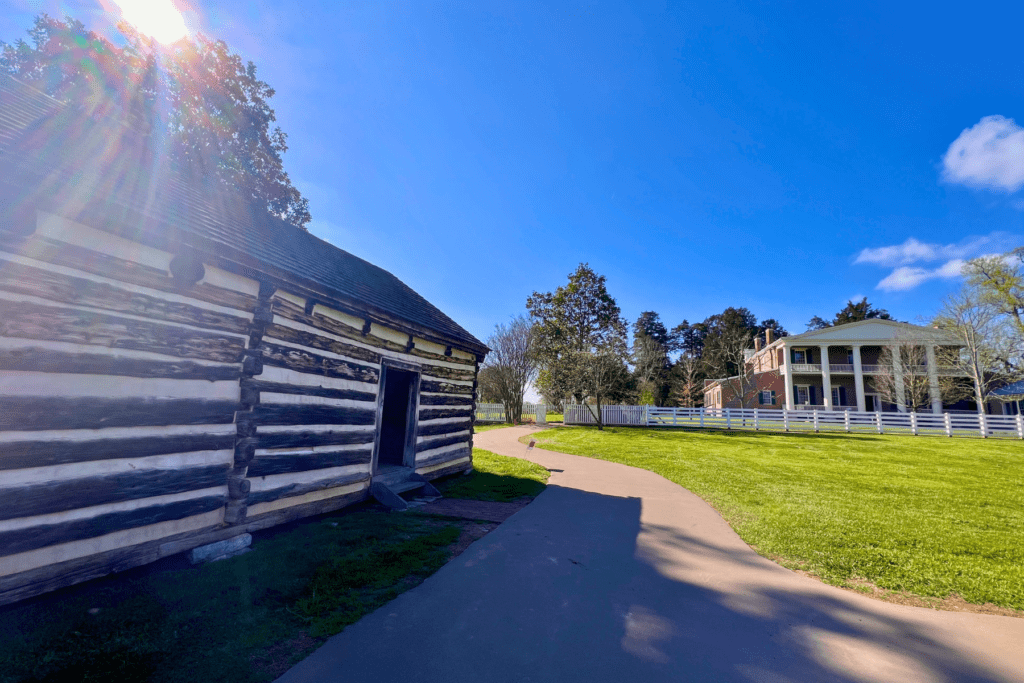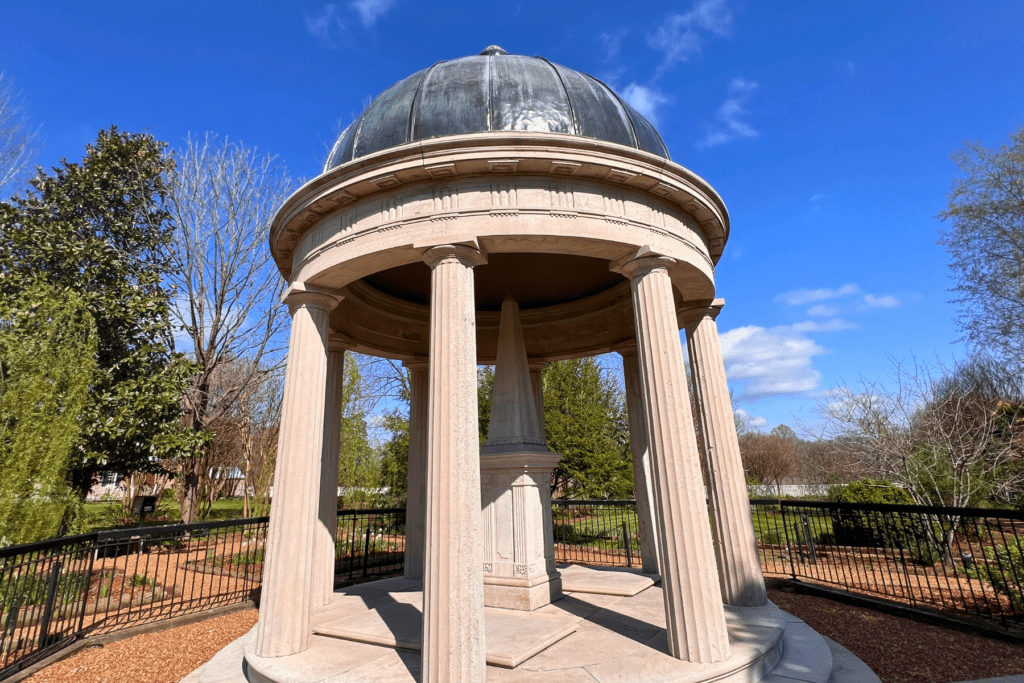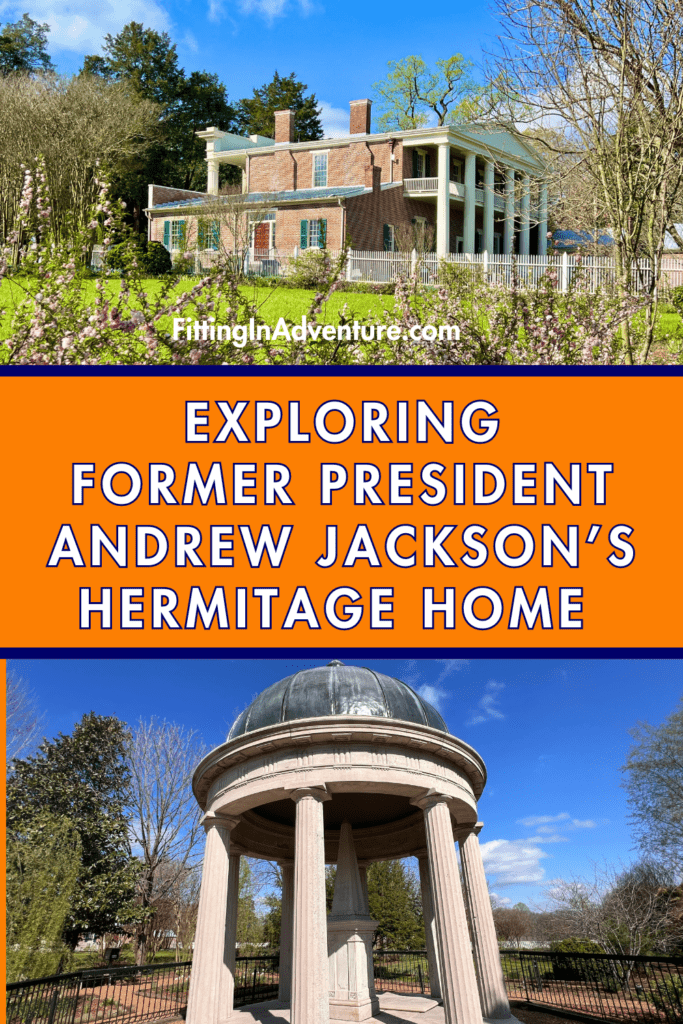The Oxford English Dictionary defines “Hermitage” as the habitation of a hermit or a solitary or secluded dwelling place. Andrew Jackson defined his home as his “place of rest”. However, it was anything but restful. At least at first.
Disclosure: Some links on our site are affiliate links. If you purchase a linked item, we will make a commission, at no extra charge to you.
Jackson purchased the property with one goal: to produce cotton as a money-making enterprise. And yes, regrettably, this was accomplished with slave labor. A fact that the Andrew Jackson Foundation does not shy away from nor downplay. The foundation strives to rediscover personal information about the enslaved men, women, and children who lived and worked on this plantation. In the 1970s, archaeologists began uncovering information about their lives at Hermitage. Since then more than 600,000 artifacts have been found. Speaking volumes regarding these individuals and their lives. This work continues even today.
The Cracker Barrel Foundation funded “Our Peace, Follow the Drinking Gourd”. A memorial for the enslaved peoples while also providing a place for everyone to reflect on the tragedy of slavery. The sculpture creator, Aaron Lee Benson, says of the memorial;
“This sculpture was not conceived nor built to make a civil, political, cultural or religious statement on slavery. It is proposed as a singular declaration of our greater hopes of a renewing of our faith in one another and a simple but eternal reminder that we are one people, one race. . .the human race.”

History of Hermitage Plantation
Andrew Jackson purchased this 425-acre farm from his neighbor, Nathaniel Hays, on July 5th, 1804. At the time, the property consisted of only a collection of log buildings for housing and storage. The original log cabin used as his farmhouse from 1804 to 1821, is still standing on the property. The Jacksons received and entertained all visitors in this simple cabin. Even distinguished visitors such as President James Monroe. Once construction of the brick mansion was complete, he converted this cabin into slave quarters.
Andrew Jackson continually added property to his plantation. And by his Presidential inauguration, it comprised 1,000 acres. A plantation is a large farm devoted primarily to growing a singular type of crop for profit. And this crop was cotton, covering nearly 200 acres. But cotton wasn’t the only crop grown here. Jackson never cultivated more than 400 acres. 200 in cotton and the rest in hay, oats, wheat, corn, and root vegetables.
There was also a dairy herd, about 150 sheep, and more than 300 hogs. There was also a blacksmith shop, spinning and weaving shops, a mill, and a cotton gin. Hermitage had orchards with several varieties of apples, pears, peaches, quince, cherries and other fruits. And because Jackson, like many during the time, was a whiskey drinker, there was a distillery on the property, as well.
But this was a completely self-sustaining plantation, so most everything needed to be handled onsite. Other buildings included kitchens, springhouses, an icehouse, and carriage houses. There were also support buildings for the plantations work such as the blacksmith shop, carpenter’s shops, a cotton gin and press, stables, a sawmill and various types of barns. Some of these buildings are still in operation because Hermitage has a modern farming operation and a seasonal cotton patch.
When Andrew Jackson passed away in June 1845, his adopted son, Andrew Jackson Jr, inherited Hermitage. But falling cotton prices, bad financial decisions and natural disasters sunk Junior deep in debt. Because of this, he began to sell most of The Hermitage farmlands to individuals, and in 1856, hoping to move operations to new locations in Mississippi and Louisiana, he sold The Hermitage to the State of Tennessee. While their new plantation was under construction, the family leased The Hermitage back from the state for two years. Once they left, agriculture at Hermitage nearly came to a halt in the years before the onset of the Civil War. In early 1861, Andrew Jackson Jr and his wife, Sarah, returned to The Hermitage. The state allowed them to live as tenants for the rest of their lives.
The Ladies’ Hermitage Association (LHA), later renamed the Andrew Jackson Foundation (AJF) in 2014, acquired the core 25-acre site and existing buildings of Hermitage from the State of Tennessee, in 1889. It has been welcoming guests ever since.

The Mansion
The original Mansion was constructed of brick, in the Federal style, and completed in 1821. The bricks used in the construction were made onsite. The first floor contained two parlors, a dining room, and Andrew and Rachel Jackson’s bedroom with a large entry hall down the middle of the house. On the second floor were four bedrooms. The house featured a basement kitchen and nine fireplaces. Later, Jackson added a simple exterior entry portico.
During Jackson’s presidency in 1831, the mansion underwent a major renovation. The mansion was redesigned by adding one-story wings, a two-story front portico with 10 Doric columns, a small rear portico, and copper gutters. The east wing had a library and a farm office. The west wing housed a large dining room and pantry. A detached kitchen and smokehouse were also added behind the 13-room, 8,000-square-foot mansion. These additions changed the house from the Federal style to Classical.
In October 1834, a fire heavily damaged the house causing much of the house to be rebuilt. The redesign changed the entrance façade. By adding six two-story columns with modified Corinthian capitals across the front porch, it took the look of a Greek-like temple. A light tan paint was added to the exterior wood structures of the front façade, along with sand coating on the columns and trim to simulate the look of stone.
Inside the house, builders moved Federal-style woodwork into the more private family bedrooms. In the public rooms, Greek Revival-style mantels and woodwork were added. The highlight of the interior additions was the cantilevered, elliptical staircase in the entry hall. This replaced the “dog-leg” staircase comprised of two straight flights of stairs with two landings.
Prior to the fire, nearly every room was covered in French-made wallpaper. Jackson instructed that the damaged paper Rachel originally selected, be replaced. Destroyed furnishings were replaced with Philadelphia Classical-style pieces. When renovations were completed, in 1837, Hermitage was perhaps the most trendy house in Tennessee.
Considered by many historians to be the best preserved early U.S. presidential home, Hermitage gives visitors a glimpse of what life was like for the family in the years of Andrew Jackson’s retirement (1837-1845). More than 80 percent of items on display are original, including furniture, wallpaper and family possessions.

Hermitage Rooms
While you can take a guided tour through the house, many rooms are off-limits to guests. You can look from outside but because of preservation efforts, you can not enter. But these rooms still have stories to tell.
Entry Hall
Stepping into the Entry Hall, visitors are greeted by a beautifully printed scenic wallpaper, a grand staircase, and the busts of two of Jackson’s cabinet members. In Jackson’s time, guests were first greeted here by Hannah, an enslaved woman who served as the Jackson family’s head of the household.
Front Parlor
The front parlor is filled with mementos from Jackson’s life and travels. Here, Jackson entertained his guests with stories from his military career.
Back Parlor
In this more informal setting, the former General and ex-president played the patriarch role to three generations of Jacksons.
Andrew Jackson’s Bedroom
As a widower, Jackson lived in this bedroom during his final years because he was not in good health. Visitors can spot his favorite portrait of Rachel and many other personal effects.
Andrew Jackson Jr and Sarah’s Bedroom
Sarah lived in the mansion, for the most part, beginning in 1832 until her death in 1887. Andrew Junior called the mansion home for the majority of his life, from 1821 to 1865. His early years were spent at the log home.
Library
After his retirement, Andrew Jackson spent much of his time in the library reading, corresponding with others, and entertaining political friends.
Farm Office
During Jackson’s Presidential term, Andrew Junior ran the daily farm business from this office.
Dining Room
Always the entertainer to many guests over the years, the Jacksons utilized this room to serve the largest meal of the day, which commenced at 3 p.m. High gloss paint was used purposefully to reflect as much light as possible.
Kitchen
An enslaved cook named Betty staffed the kitchen. She cooked meals for up to 25 people on any given day. Visitors may notice a trap door under the table, which leads down into a root cellar.
Little Rachel’s Room
The rooms on the second floor were used for different people, depending on the needs of the household. One is decorated as it might have looked when Jackson’s only granddaughter, Little Rachel, lived here.
Andrew Jackson III and Samuel’s Bedroom
Jackson’s grandsons, Andrew III and Samuel slept here, along with several cousins. Andrew III and his family were the last people to live at The Hermitage, leaving in 1893.
First Guest Room
This room provided more privacy than the other bedrooms and was therefore reserved for the most important guest each evening. Such notable guests, like James K. Polk, Sam Houston, and Martin Van Buren, slept here.
Second Guest Room
Unannounced guests, whom the Jacksons welcomed from all walks of life over the years, slept in this room. The room features two beds, making it the least private.
Andrew Jackson’s Tomb
In 1831, Jackson hired architect David Morrison, the same architect to remodel The Hermitage, to build a tomb for both Rachel and him. The Greek architectural style mirrored the design selected for the mansion. Jackson would write many letters home wanting information on the progress of the tomb’s construction. He had a good reason for his impatience. When Rachel passed away unexpectedly on December 22, 1828, Andrew Jackson had yet to make any preparations for their final resting place. He decided to bury Rachel in her garden because it was her favorite place. A small frame house was erected over her limestone burial crypt until a more suitable tomb was built.
When the tomb was completed, Jackson began landscaping the area around it and restoring the garden that had declined since Rachel’s death. He specifically instructed hickory trees and willows be planted near the tomb. In September 1832, Jackson set aside a small area to the south where other family members are buried in an adjoining plot. When Jackson returned to The Hermitage at the conclusion of his second term in 1837, he visited the tomb daily as long as his health allowed. When he was unable to visit in person, he could easily see the tomb from his library.
Andrew Jackson died on June 8, 1845 and was laid to rest two days later in the tomb. The inscription simply reads, “General Andrew Jackson, March 15, 1767 – June 8, 1845.” In the years after Jackson’s death, the tomb and garden suffered as the family’s wealth ebbed. After Andrew Jackson Jr sold the property to the State of Tennessee in 1856, various proposals were introduced to move Jackson’s body and tomb to the State Capitol. Fortunately, none of those plans were realized, and the Jackson tomb is intact at The Hermitage. Still today, the garden receives landscaping maintenance to preserve this very special place for both Andrew and Rachel Jackson.

Born for a Storm Exhibit
For more than 200 years, Andrew Jackson, America’s seventh president, has been a lightning rod that has inspired, shaped, and transformed America and the image of Americans. The exhibit tells the story of Andrew Jackson’s rise from his humble beginnings as an orphan, his military career, to his presidency through interactive displays. After being hailed hero in the Battle of New Orleans, he went on to win the admiration of countless Americans who hungered for a “people’s leader.”
The exhibit reveals some of the enormous contrasts, conflicts and contradictions of Jackson. The man who reshaped America and redefined American politics.
A Visit to Hermitage
Andrew Jackson’s Hermitage is one of the best-preserved Presidential homes. It is both a working farm and museum to one of America’s most famous, and controversial, Presidents. A walk through the mansion and around the grounds provides a glimpse of Jackson’s life in the 1830s. Through painstaking research and excavation, the Andrew Jackson Foundation has restored The Hermitage to as close to what it was like when he lived here. Exhibits further tell the story of all those who lived and worked here, including the Enslaved Community.
Located approximately 11 miles east of Nashville, at 4580 Rachel’s Lane, Andrew Jackson’s Hermitage offers various passes and tours from which to choose. Additionally, they offer a Military discount for Active Duty and Military Veterans. The Grounds Pass allows access to the 1,120 acres full of history and beauty. The Mansion Tour takes you through the beloved home of our 7th President.
While these tours are the more economical choice, a VIP tour is available as an add-on where you will experience The Hermitage unlike anyone else.
On this two-hour walking tour, an experienced guide will lead you on your tour through The Hermitage Mansion, with a once-in-a-lifetime opportunity to take in the view of the grounds from the beautiful Hermitage balcony. Your guide will also take you on a tour of the grounds, Jackson’s tomb and the garden. Your ticket also includes a discounted wine tasting at their onsite tasting room, if you are over 21, of course. These are available most days at 10 a.m. and 2 p.m. and each tour can accommodate 12 people.
Another available add-on is the “In Their Footsteps: Lives of the Hermitage Enslaved Tour”. This tour highlights the lives of the enslaved men and women who lived here during the life of Andrew Jackson and after his death, including Alfred, the wagoner, and Betty, the cook. You will learn how vital the enslaved were to the operation of the farm, the harsh reality of the enslaved system, and how they endured until gaining their freedom. These tours are offered at 1 p.m. and can accommodate 12 people.
“The Hermitage Enslaved: A Wagon Tour” offers a glimpse into the history associated with The Hermitage enslaved community from a truly unique experience. This 30-minute horse-drawn wagon tour takes you back in time as you travel beyond the mansion and into the fields past archaeological sites associated with slavery. While most tickets to the tours can be purchased online, this particular one cannot. You must buy these tickets at the ticket office upon your arrival. Because it is a wagon ride, inclement weather can affect tour availability.
“The Hermitage Garden & Arboretum Tour” takes you through the beautiful and historic one-acre garden that has been captivating visitors for more than 130 years. Guided by the Historic Garden Manager, you will learn the historical significance of the garden, see the seasonal flora in bloom, and see trees that are part of the site’s Level III Arboretum as certified by the Tennessee Urban Forestry Council. Limited again to 12 people, the tour is offered weekly at 10:30 a.m. on Thursdays, March through December, and includes the Mansion Tour.
The Commander in Chief walking tour gives visitors a 90-minute glimpse of the grounds, mansion, garden and tomb where the President and Mrs. Jackson are buried. While in the mansion, visitors have the opportunity to take in the view from the beautiful Hermitage balcony! If you choose this tour, it must be arranged at least two weeks in advance.
Group tours can also be arranged. Prices were not included in this article due to the possibility of changes over time.
Accessibility

Those with limited mobility will find that Hermitage is very accommodating. For those unable to walk around the grounds, wheelchairs are available free of charge. While motorized and non-motorized wheelchairs can be used in the mansion, the size of the interior spaces prevents the use of motorized scooter chairs. And while the family pet must stay home, assistance animals are always welcome. For those with hearing impairments, printed mansion and audio tour scripts are available upon request and the film is closed-captioned, as well.
The Visitor Center, theater, exhibit gallery, and Museum Store and cafe are completely accessible for those in wheelchairs. The pathways are smooth asphalt, and the garden has a ramped entrance. If you are unable to climb the stairs during the Mansion Tour, a photographic tour of the second floor is available.
There are printed translations of the mansion tour in Spanish, German, French, Russian and Japanese. For those with visual impairments, braille and large print site brochures can be checked out at the Audio Desk. The brochures also include touch-sensitive maps of the property. And for those on the Autism Spectrum Disorder and other neurodivergent conditions, a Visual Schedule and a Social Story can be provided. Quiet space is usually available at the Cabin-by-the-Spring terrace, the Education Center porch or along the Nature Trail. These can be borrowed from the Information Desk.
For any specific accessibility or other assistance needs, we suggest contacting The Hermitage directly.


